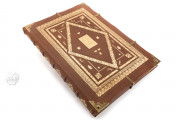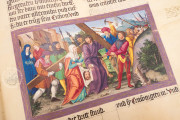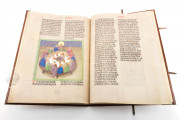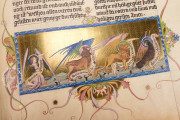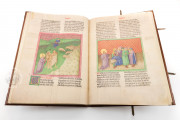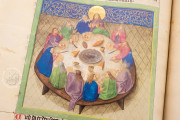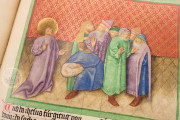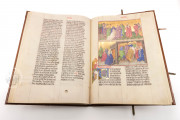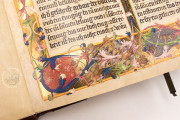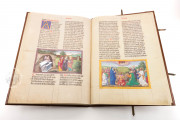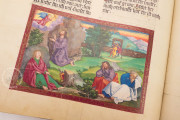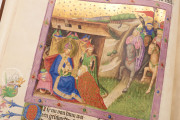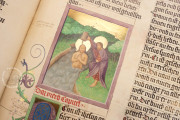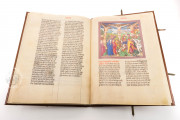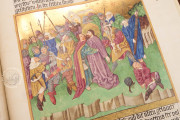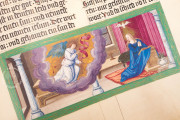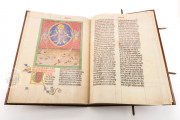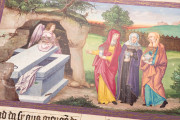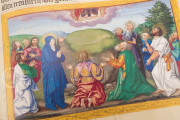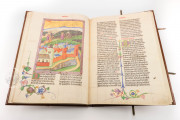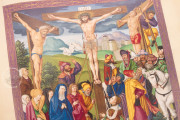Around the year of 1425, an anonymous member of the court commissioned one of the finest German Bible manuscripts in Regensburg. From the 10th century, the illuminator's workshops in Regensburg inspired the schools of the Danube region, where monasteries were specialized in the creation of luxuriously illustrated manuscripts that still impress us today with their quality decoration.
Ottheinrich, the bibliophile Elector Palatine (1502-1559), bought the manuscript at around 1530 as a showpiece for his world-famous Bibliotheca Palatina in Heidelberg. Thanks to him, this magnificent work-of-art of the German languagewas saved for later generations.
Ottheinrich hired the Renaissance master Matthias Gerung to continue with the decoration of the manuscript and the artist made it into the unequaled and sumptuous edition of the New Testament that we know today. Written in the early High German language, the book can be easily understood by modern readers.
The Oldest Illustrated Gospels in the German Language
In total, eight volumes containing the New Testament texts in German have come down to us, three of which are now kept in the Bayerische Staatsbibliothek.
The first two volumes of Ottheinrich's Bible, compiled into one volume for conservation reasons under the shelfmark Cgm 8010/1.2, encompassed the Gospels of Saint Matthew and Saint Mark as well as portions of the Gospel of Saint Luke.
Their importance among the masterpieces of German art cannot be overstated. Ottheinrich's Bible is also of high interest in the history of the German language since it was written 100 years before Luther's translation of the New Testament.
Made by the Best Artists
Ottheinrich's Bible is an elegant/courtly masterpiece, lavishly illustrated with sparkling gold and precious colors. Whoever commissioned it originally intended more than the simple ordering of a luxurious manuscript. The main aim must have been to possess a work representing the culmination of the accomplishments of the most eminent artists of his time.
The two principal masters came from the school of Master of the Worcester Carrying of the Cross, the leading Regensburgian artist of this period. Named after the Gospels in Ottheinrich's Bible, they are referred to as the Master of Saint Matthew and Saint Mark.
Courtly Luxury on Finest Vellum
78 folios in the representative format of 53.2 x 37.2 cm are ornate with 46 miniatures on a gold leaf ground, which is additionally decorated with the most exquisite gold chasing. The layout and design of the miniatures frequently covering half a page and sometimes a full page, is in the style of panel paintings.
More than 40 gold initials with colorful vines are spread throughout the text which is written in two columns. Secular themes from courtly life are hidden in playful details: a hunted stag, a loving couple, a court jester, and all kinds of colored birds are found in the decorative scrollwork.
The Unmistakable Hand of the Masters
Most miniatures go back to the Master of Saint Matthew whose paintings recall the style of Giotto. His color pallet comprises violet and grey tones, to underline the modeling of figures.
The Master of Saint Mark also follows Italian models in his work. As a talented storyteller, he tries to enliven the scene to be depicted by an exaggerated visionary drama.
Both painters were active in the same workshop and had access to the same Italian models. It was a common situation in Regensburg where masters from Padua and Verona worked together.
Although sharing a common stylistic background, both artists, however, developed their own technique of painting to the utmost perfection.
The Confusion of the Thirty Years' War
At the time of the Thirty Years' War, during the conquest of Heidelberg, Duke Maximilian of Bavaria transferred Ottheinrich's Bible to the court library in Munich, from where it was then looted by the Swedish troops and taken to Gotha in 1636.
The masterpiece was taken apart and rebound in the late 19th century. Five volumes returned to Heidelberg as an exchange, while the Bavarian National Library had to wait until 1950 to acquire the volumes containing the most lavishly decorated Gospels of Saint Matthew, Mark, and Luke from a private collector.
We have 1 facsimile edition of the manuscript "Ottheinrich Bible": Ottheinrich-Bibel facsimile edition, published by Faksimile Verlag, 2002
Request Info / Price

